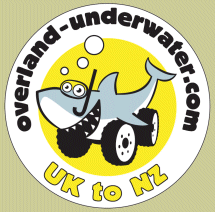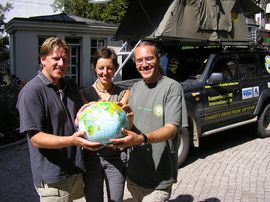| Final Statistics: Alex & Maz | Total distance: 93,550km |
| Furthest Point: Rotorua, NZ | Now settled in Sydney, Australia |
| Final Statistics: Martin | Total distance: 79,698km |
| Furthest Point: Hobart, Australia | Now settled in Bristol, UK |
In the Footsteps of Lara Croft
Cambodia, Country 21, Diary entry 1st-5th May 2006, Total distance in Cambodia : 2478km
Following the latest diary entry about our diving with Scuba Cat, I spent another day in Phuket sorting out yet more problems with the car and other admin tasks before the 12 hour drive back north towards Bangkok. Continuing our theme of getting someone else to do the work round here whenever possible, our latest guest writer is Ian Pitwood (also known as The Father) who flew out to Bangkok to join the expedition for three weeks as it entered Cambodia.
I'm not sure how I come to be writing this. On the flight from London to Bangkok, it was quite clear in my mind that, on the Cambodian leg of my journey, I would be in charge of complaining and criticising while Martin's role was to endure the moaning with stoicism, to ensure that he avoided the bumpy bits while I had my afternoon nap and to write the diary reports in glowing terms about what scintillating company I had been and how much I'd contributed to his enjoyment of the "great adventure".
It soon became clear that Martin had different ideas and despite using such compelling arguments as "But, I've had a bad back" and "Because I'm The Father" he wasn't convinced. I now have to resign myself to the fact that at least I can share my complaints about the heat and criticism of the driving with a much wider audience.
I knew I ought to be well rested after 11 hours of enforced inactivity in the untrammelled luxury of a British Airways economy class seat. However, I had insisted that my first night in Thailand should be spent in a decent hotel. I had therefore booked two nights at the Miracle Grand Convention Hotel about 15 minutes from the airport. The plan was for Martin to arrive the day before me and check in which he duly did, after driving for a day and a half to get back up to Bangkok from Phuket in the south of Thailand.
After an uneventful trip 14 hour trip from home, Martin met me at the airport and we made our way back to the hotel for me to freshen up - a shower was top priority. This was followed by a taxi ride into the centre of Bangkok for a meal in a restaurant previously given the seal of approval by The Mother and me several years ago. The quality was still good and had the bonus(?) of a gamelan band plinking and plunking in the background. Wandering around the local streets, we tried not to show too much surprise when confronted by two women taking their baby elephant for a walk along the pavement surrounded by rush-hour traffic. Our stroll also yielded Sri Mariammam, a technicolour temple in the Indian Hindu style in the 1860s by Tamil immigrants - unexpected in a country of so many Buddhist temples of such a very contrasting style.
Next day, having had a hearty breakfast at the hotel, we set off at the crack of ten o'clock on our way to Cambodia. The roads in Thailand made the journey to the border a relative pleasure but from then onwards it was a very different story. Even our passage through the border checks was quite painless, certainly when compared with some of the other accounts appearing earlier in this narrative. For some reason, the Thai authorities needed us to fill in a form that was clearly intended for use by passenger aircraft as it called for details of crew and passengers. For the record, Martin put himself down as Pilot and me as steward. I didn't mind this until later when he asked me when I'd be serving the cocktails and hors d'hoeuvres. 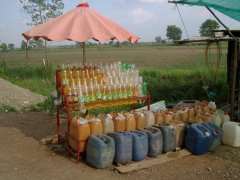
Soon after crossing the border we noticed a series of rough-looking stalls displaying assorted unlabelled plastic bottles of a mysterious pinkish liquid. At first we were a little puzzled but soon remembered a reference to fuel smuggling across the Thai-Cambodian border in the Lonely Planet guide. These were fuel stations! These stalls are scattered throughout the towns but seem to be concentrated on the roads out into the country. Fortunately there are legitimate fuel stations in the towns too so we wouldn't be forced to risk the dubious quality of the contents of the pop bottles.
About 130 of the 150 km were a nightmare. The limited stretches of metalled roads were sprinkled with potholes, the unpaved sections were rutted and full of pits and lorries threw up clouds of dust. There were detours around the majority of bridges across the dried-up riverbeds, presumably to ensure that they would still be intact when the rains come. All this delayed progress considerably and it was well and truly dark before we arrived to look for a hotel. During our search we turned down the Amansara and the Raffles Grand Hotel at around US$700 a night but eventually settled for a clean and comfortable place within walking distance from the town centre. Our hotel? US$13 per night. Being so close to the centre of things, eating is no problem as we are spoiled for choice of restaurants. After an excellent Khmer meal we retired to our hotel room to "research" our next day's entertainment.
We had decided that we'd allow at least three days for "doing" Angkor Wat and its surrounding temples. For the first day, in order to get a flavour of the history and background behind the sights we were seeing, we treated ourselves to a guide. Tek proved to be excellent, had very good English and was very knowledgeable. He was also quite happy to give us a Cambodian's view of the civil war and subsequent misery of the 3 years, 8 months and 20 days of the Pol Pot regime - yes, he knew how long it was down to the last day. He told us that time he lost a brother, an aunt and four brothers. Tek himself was forced back into the fields during the wet rice-growing season and was then sent to the forests to cut timber in the dry. He prudently hid the fact that he spoke English as this would have branded him as a lackey of imperialist America and sealed his fate. 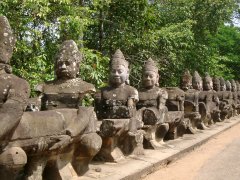
We started at Angkor Thom (Great Angkor, or Great City), some 10 sq km in extent. At its height, it may have supported a population of one million people in the surrounding region. Centred on Bayon temple, Angkor Thom is enclosed by a square wall 8m high and 12km in length and encircled by a moat 100m wide, said to have been inhabited by crocodiles. Much of the moat is still silted up and overgrown but work continues on clearing it out for its full length. Access across the moat is via a causeway flanked by balustrades consisting of naga (snakes) supported by gods on one side and demons on the other.
Bayon is a place of low corridors, very steep flights of stairs and, best of all, a collection of 54 gothic towers decorated with 216 enormous, smiling faces of Brahma (four for each tower) but that are believed to bear a more than a passing resemblance to the great King Jayavarman VII who built it.
These huge heads glare down from every angle. As you walk around, a dozen or more of the heads are visible at any one time - full-face or in profile, almost level with your eyes or staring down from above you. Our guide suggested that the Khmer empire was divided into 54 provinces at the time of Bayon's construction, hence the all-seeing eyes of Brahma (or Jayavarman VII) were keeping watch on the kingdom's outlying subjects.
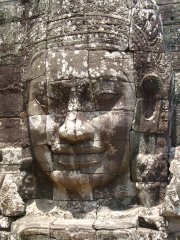
Next we moved on to Baphuon which would have been one of the most spectacular of Angkor's temples in its time. Located 200m northwest of Bayon, it's a pyramidal representation of mythical Mt Meru from Hindu mythology. Construction probably began some 300 years before the Bayon temple and was later completed in the mid 11th century. It marked the centre of the city that existed before the construction of Angkor Thom. It has suffered badly over the years and, an earlier restoration attempt having been interrupted by the civil war, it is now undergoing extensive renovation sponsored by UNESCO. The original estimate of eight years soon stretched to 10 and work is still only about half complete after 11 years.
The 350m-long Terrace of Elephants was used as a giant viewing stand for public ceremonies and served as a base for the king's grand audience hall. The middle section of the retaining wall of the terrace is decorated with life-size garuda (a mythical creature which was human with a bird's head); towards either end are the two parts of a parade of elephants, complete with their Khmer mahouts.
In front of the terrace is a vast area called Central Square across which infantry, cavalry, horse-drawn chariots and elephants would parade for review by the king. Beyond this area, about half a mile away from the Terrace stand a row of towers known as the Prasat Suor Prat or Temple of the Tightrope Dancers which marked the area where the common people were allowed to stand in order to see their king - not that they'd be able to see much of him from half a mile away. It is said that artistes performed for the people's entertainment on tightropes strung between these towers.

Tek's suggestion was that we should have lunch in a cafe near the entrance to Angkor Wat but it was overpriced and with an uninspiring selection of dishes so we returned to the car and lunched on cold drinks and flapjack (made by my own loving hand and nursed all the way from the UK). Our guide probably dipped out on a free lunch from the restaurant owner but, hey, that's his problem.
The only penalty was the need to fend off several local children who were intent on selling us postcards; rip-offs of The Lonely Planet - Cambodia; or local souvenirs. Their English was mostly excellent despite never having been to school - the need to make a buck or two must be a powerful incentive. Once they'd got the message that we weren't going to buy they proved to be charming and polite kids and were very interested in all the goodies tucked away in Martin's 'cruiser.
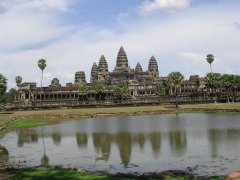
The afternoon was spent touring Angkor Wat. Angkor Wat is widely believed to be the largest religious structure in the world. It is also the best-preserved temple at Angkor as it was never abandoned to the jungle. It was probably built as a funerary temple for Suryavarman II (reigned 1112-52) to honour Vishnu, the Hindu deity with whom the king identified.
Angkor Wat is famous for its beguiling apsara (some say heavenly nymphs, others dancing girls). There are more than 3000 carved into the walls of the temple, each of them unique, and there are more than 30 different hairstyles for budding stylists to check out. Many of these exquisite apsara were damaged during Indian efforts to clean the temples with chemicals during the 1980s, the ultimate bad acid trip, but they are now being restored by the teams of the German Apsara Conservation Project.
Angkor Wat is surrounded by a moat, 190m wide, which forms a giant rectangle measuring 1.5km by 1.3km. It makes the moats around European castles look like child's play. From the west, a sandstone causeway crosses the moat. The sandstone blocks from which Angkor Wat (and Angkor Thom) were built were quarried more than 50km away and floated down the Siem Reap River on rafts or else carried by elephants during the dry season when the river was insufficiently deep. The logistics of such a task are mind-blowing, consuming the labour of thousands - an unbelievable feat comparable with the pyramids and temples in Egypt but with much smallr blocks than in Egypt.
By four o'clock, Martin and I decided that the prospect of staying on for a further two hours in the heat and humidity to watch the sun set over Angkor Wat, as recommended by Tek, was not an appealing one so we dropped him off at the information centre and adjourned to our air-conditioned room for a shower and attended to domestic matters before gathering the strength for our main meal of the day. 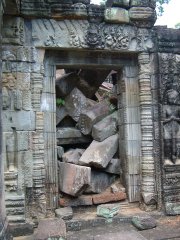
On day two in the Siem Reap area, we decided to tour some of the less popular temples in the vicinity of Angkor Thom and Angkor Wat. The temple of Preah Khan (Sacred Sword) is one of the largest complexes at Angkor, although it generally gets fewer visitors. It was built by Jayavarman VII and it probably served as his temporary residence while Angkor Thom was being built. The temple of Preah Khan is in a reasonable state of preservation and ongoing restoration efforts by the World Monuments Fund should ensure stabilisation but it does mean you have to try to ignore the strange wooden constructions and cast concrete pillars put in place to stop it from collapsing any further. Many of the passageways are completely blocked by stones from the collapsed buildings.
Preah Khan covers a very large area, but the temple itself is within a rectangular enclosing wall of around 700m by 800m. Four processional walkways approach the gates of the temple, and these are bordered by naga balustrades, as in the approach to Angkor Thom. However, here most of the heads of the gods and demons have disappeared. Approaching from the west as we did, there is little clue to nature's impact, but on the outer retaining wall of the east gate, a pair of trees with huge roots cling to the walls 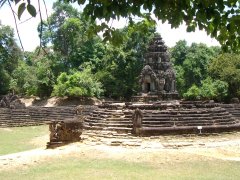
Down the road about 3 km we found something a bit different, the temple of Preah Neak Pean (Intertwined Naga) is a small perfectly symmetrical temple constructed byJayavarman VII. It has a large square pool surrounded by four smaller square pools. In the centre of the central pool is a circular 'island' encircled by the two naga whose intertwined tails give the temple its name.
Water once flowed from the central pool into the four peripheral pools via ornamental spouts, which can still be seen in the pavilions at each axis of the pool. The spouts are in the form of an elephant's head, a horse's head, a lion's head and a human's head. The pool was used for ritual purification rites.
Ta Som, was a further 3 km on from Preah Neak Pean. Before exploring the ruins, we decided we needed something to keep our strength up so made sandwiches and sat in the shade to eat them. As before, crowds of locals (adults as well this time) came to enjoy the sight of us at the trough. Again their English was good and they were very interested in the trip and the vehicle. 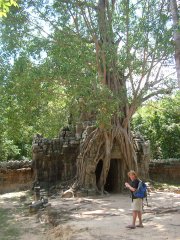
The central area of Ta Som is in a ruined state, but restoration by the World Monument Fund is getting closer to completion. The most impressive feature at Ta Som is the huge tree completely overwhelming the eastern gopura (entrance gateway).
Then we just had to call in at Ta Prohm (Tomb Raider Temple). The appeal of Ta Prom lies in the fact that, unlike the other monuments of Angkor, it has been left to be swallowed by the jungle, and looks very much the way most of the monuments of Angkor appeared when European explorers first stumbled upon them. Well, that's the theory, but in fact the jungle is held back and only the largest trees are left in place. Still, a visit to Ta Prohm is a unique experience.
It is a temple of towers, small courtyards and narrow corridors. Many of the corridors are impassable, clogged with jumbled piles of delicately carved stone blocks dislodged by the roots of long-decayed trees. The walls bulge and are covered by lichen, moss and creeping plants, and shrubs sprout from the roofs of monumental porches. Trees, hundreds of years old tower overhead. The most popular of the many strangulating root formations is that on the inside of the easternmost gopura of the central enclosure. However, there are several other astounding growths including the famous Tomb Raider tree where Angelina Jolie picked a jasmine flower before falling through the earth into . . . Pinewood Studios. 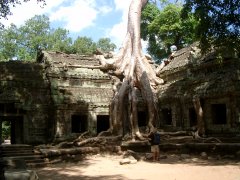
We wanted to return later to Angkor Wat to see the sun set on the temple so decided that this was enough for the main part of the day but as our route back to he hotel took us past the Bayon again and the sun was much lower than when we'd called in the previous day, we stopped off to take more photos in a less harsh light which we hoped would give us better results . . . arguably with a degree of success.
Our return to Angkor Wat was a disappointment as there were dark clouds looming on the western horizon so there was no sun to set. However, it was an opportunity to sit and watch the bevies of (mostly Asian) tourists being shepherded around by their minders and feel very superior that we were there totally independently and had no hard and fast schedule to make us move on.
On returning to the hotel again, Martin checked under the front of the car because of an ominous creaking which had developed since driving the rough roads from the Thai border. He found a puddle of oil dripping from one of the front shock absorbers which was bad news.
For our final day in the Angkor area, Martin decided that we could afford to live with the shock absorber problem and see a couple more places of interest before our 3-day visitors' pass ran out. So we set off for Banteay Srei which is a Hindu temple dedicated to Shiva and is about 32km from Siem Reap. It is cut from stone of a pinkish hue and includes some of the finest stone carving to be seen anywhere. It is one of the smallest sites at Angkor, and it is well preserved. Banteay Srei means 'Citadel of the Women' and it is said that it must have been built by a woman, as the elaborate carvings are too fine for the hand of a man. I guess it must have been a woman who said that! 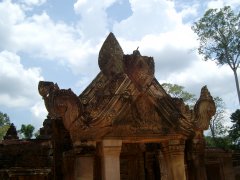
Banteay Srei was the first major temple-restoration undertaken by the Ecole Francaise d'Extreme Orient (EFEO) in 1930. The project was clearly a major success and soon led to other larger projects such as the restoration of Bayon. However, it was not the first time the temple had hit the headlines, because in 1923 Frenchman Andre Malraux was arrested in Phnom Penh for attempting to steal several of the site's major statues and pieces of sculpture. Ironically, Malraux was later appointed Minister of Culture under Charles de Gaulle.
Next stop Kbal Spean which is a carved riverbed, set deep in the jungle to the northeast of Angkor. Shortly after leaving Banteay Srei, the road was unpaved and had degenerated into a series small closely-spaced ridges. These set up an enormous vibration in the car and required careful choice of speed to minimise it. Fast seemed better than slow! We put too much faith in the information in the Lonely Planet at this point which said that we had a further 18 km to go from our previous stop. In the event it proved to be only 14 km so having overshot our target by several km we doubled back and quickly found it.
We parked and picnicked in the shade of some very considerately provided shelters with the usual visits from curious locals. We also had a long chat with two of the many Chinese visitors we have seen in the Siem Reap area. They both spoke excellent English and showed great interest in the route the team had taken, especially through China. They were clearly members of the Chinese privileged class as they discussed their extensive travels around their own country and throughout Asia.
More commonly referred to in English as the 'River of a Thousand Lingas', Kbal Spean actually means 'bridgehead' - a reference to the natural rock bridge at the site. Linga (phallic symbols) have been elaborately carved into the riverbed, and images of Hindu deities are dotted about the area.
It is a 1.5km uphill walk to the carvings although, with the temperature in the mid 30s it seemed a lot further, both going up and coming down. Our route took us along an attractive path that winds its way up into the jungle, passing over quite rugged boulder formations along the way. The path eventually splits to the waterfall or the river carvings. We decided to give the waterfall a miss as there was little more than a trickle in the river at the end of the dry season.
There is a series of carvings at the bridgehead itself, many of which have been hacked off in the past few years. Vandalism doesn't just happen in the West. This whole area is now roped off to protect the carvings from further damage. The carvings themselves were nothing compared with what we had been seeing at all the temple sites so we were both distinctly underwhelmed. The linga in the riverbed were numerous but equally unimpressive. We were both reminded of the little knobs on top of a Lego brick - but bigger, as a phallic symbol should be! All in all, we were rather disappointed with what we found especially after having climbed all that way. 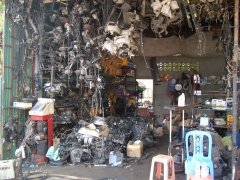
Heading back to Siem Reap we decided that trying to get the shock absorber sorted out took priority over any further sightseeing and so we started looking out for a suitable workshop or garage. What we found was little more than a shed just off the road which had two or three cars out front in various states of repair. In the building itself was an Aladdin's cave of all sorts of spare parts some new but most used. They were piled up in heaps and hanging in enormous strings from the ceiling with no apparent way of finding anything when it was needed. Fortunately Martin had a spare shock absorber so this didn't bother us.
Luckily, one of their other customers spoke fluent English and was happy to negotiate on our behalf. In no time one of the mechanics had dived under the car and under the bonnet and assessed the situation. Yes, he could do the job and half an hour and US$5 later we were ready to go again. Our interpreter had spent 3 years in the USA studying music which accounts for his English skills. He is the only professional Tenor in Cambodia. If you get to read this Khuon Sethisak, please accept our thanks once more. His web address is www.sethisak.com if anyone wants to learn more about him.
With that good job done, we returned to base to ready ourselves for the journey down towards Phnom Penh and the Mekong River.
| All content copyright � overland-underwater.com - please do not use without permission. |
| Comment from Scooter |
| Hi Guys, Maz and the 'Father' - I seem to recall those same dodgy pop bottles in Mozambique but on that occasion I'm sure 'Rubber Duck' actually had to use some on account of the lead in Alex's right boot, or was that Will's .. ah one forgets the finer detail ;0) |
| 11 Jun 2006 @ 19:34:30 |
